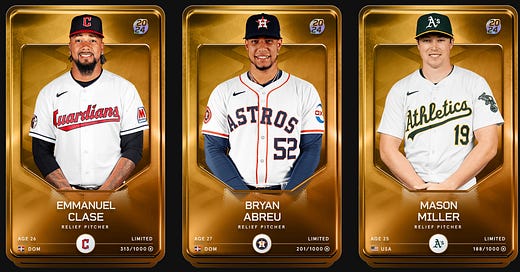Welcome to the first official Sideline Sports Hub article.
I changed the URL to this Substack, however, all previous links from hunterlangille.substack.com will redirect to sidelinesportshub.substack.com.
I could only do this once, so there is no going back.
Hopefully I didn’t screw anything up.
Anyways, thank you to the ten people who have already subscribed, despite baseball being over two months away.
As promised, here is the first preseason article.
This one will break down arguably the toughest position to figure out in the game, Relief Pitcher
What To Look For In An RP?
There are six main things I look for when deciding which relief pitcher to roster in Sorare MLB.
Is he a closer or a relief pitcher?
How many games does his team have?
Is he the only closer for his team?
Is his team in a position to win the series (but not by too much)
How much rest has that closer received lately?
Does he have multi-position eligibility?
Let’s break this down:
Closer vs. Relief Pitcher
This may be a fairly obvious distinction for people who are more experienced with fantasy baseball, but for those who are new, it is important to distinguish the two.
I would say it is almost always the right move to roster a closer over a relief pitcher in Sorare MLB.
The main reason is that they are much more dependable.
Most Major League teams have about eight pitchers available in their bullpen.
These pitchers are also categorized into different roles, such as long relievers, middle relievers, left/right-handed specialists, setup men, and closers.
Long relievers will come into a game if a starter gets pulled early due to injury or poor performance.
A long reliever could get significant innings in such a scenario, but it is rather hard to predict if /when such a pitcher would enter the game.
A middle reliever typically comes into the game in the 5th, 6th, or 7th inning, typically after the starting pitcher has reached an elevated pitch count.
Teams will carry a few of these guys so it’s hard to determine which one to roster.
There’s a chance that a long reliever or a middle reliever can earn the win (A nice 5-point bonus in Sorare MLB) but it’s much more likely that a win or loss goes to a starter than a reliever.
Sorare MLB did allow a 5-point bonus for a Hold at the start of last season, in an attempt to add more value to non-closer bullpen pitchers.
A reliever can earn a “hold” by entering the game with a lead of three runs or less, and maintaining that lead while recording at least one out.
So if a reliever doesn’t earn the win, he can still get ten points total from the relief appearance (5 points) and the hold (5 points).
This sounds pretty good, but again, it’s a bit hard trying to predict all these different events falling into place.
Now what we really want to target are closers.
This is because closers are the likeliest to earn the coveted 10-point save.
So yes, a closer typically pitches just the ninth inning.
But an appearance gives him 5 points off the bat, a save gives him another 10, he gets another 3 for completing the ninth, and he gets 2 points for however many strikeouts he gets, something closers are very good at.
And finally, like I mentioned before, closer are highly dependable.
Most teams have one designated closer, and several teams have an elite closer who can get 50+ opportunities in a season (Ryan Helsley led MLB with 49 saves and over 53 opportunities last season).
So all this to say, when picking which RP to roster in Sorare MLB, it makes the most sense to always prioritize a closer.
Number of Games Is King
With the way the Game Weeks work in Sorare MLB, we should always be looking for how many games that pitcher has in each Game Week.




